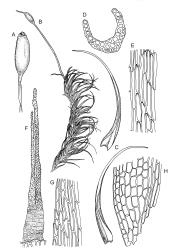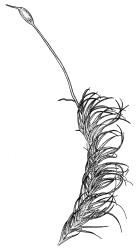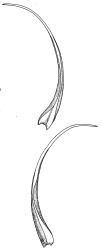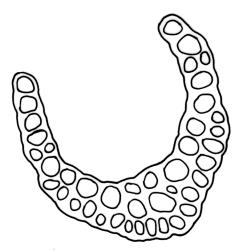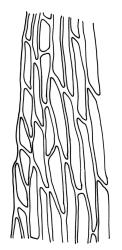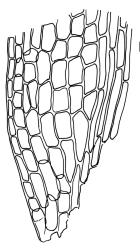Dicranum aucklandicum sensu Sainsbury (1955)
Plants golden, lustrous, and turf-forming. Stems 6–13 mm, in cross-section with 1–2 layers of firm-walled cortical cells and a central strand, with extremely sparse, smooth, brown rhizoids below. Leaves strongly falcate-secund, little altered when dry, narrowly lanceolate, mostly 2.8–3.2 mm, ± entire or with a few teeth at extreme apex; mid laminal cells elongate and somewhat irregular, mostly 3–7:1, firm-walled, smooth; basal cells oblong, rounded and slightly projecting at ends, mostly 24–60 µm and 4–7(–10):1, firm-walled; alar cells forming a rather large but poorly defined group of subquadrate cells surrounding a few weakly inflated and weakly pigmented cells in extreme angles. Costa c. ⅙ the width of the leaf base, filling about the distal ⅓ of the leaf, in cross-section (mid leaf) lacking stereids.
Autoicous. Inner perichaetial leaves c. 3.8 mm, abruptly tapered from a strongly sheathing base to a stout subula c. ½ the total leaf length. Perigonia terminal on elongate innovations. Setae c. (6–)8–11 mm; capsules erect or nearly so, slightly curved, oblong-cylindric, 1.0–1.3(–1.5) mm, not strumose, nearly smooth; exothecial cells mostly 3–5:1, firm-walled, irregular; stomata few and restricted to extreme capsule base; annulus well differentiated, revoluble; operculum nearly equal to the capsule. Peristome teeth inserted c. 60 µm below mouth, c. 300 × c. 35 µm, divided ½–⅔ their length and regular (not cribose), trabeculate on outer surface and a zig-zag line on inner surface, orange-brown below, hyaline above, striolate at base, coarsely baculate for at least ¾ their length. Spores 15–19 µm, minutely papillose.
Dixon 1915, pl. 9, fig. 2 (as Dicranum aucklandicum). The material illustrated by Malcolm & Malcolm 2003, p. 38, does not appear to be representative.
Kiaeria pumila (Mitt.) Ochyra (=Dicranum aucklandicum Dixon) is sometimes confused with Holomitrium trichopodum (=Dicranum trichopodum Mitt.). Compared to the latter, K. pumila is a smaller plant with shorter stems, shorter (c. 3 mm vs c. 6–13 mm) leaves, a narrower costa (c. ⅙ the leaf base width) which lacks stereids, more elongate mid and upper laminal cells, autoicous rather than pseudautoicous sexuality, much shorter (c. 6–11 mm vs mostly 20–40 mm) setae and capsules (c. 1.0–1.3 vs mostly 2.0–2.5 mm), and differing peristome teeth.
In a N.Z. context, Kiaeria pumila could also be confused with Ditrichum brevirostre, especially when sterile. Kiaeria pumila differs from the Ditrichum by having longer vegetative leaves (c. 2.8–3.2 mm vs c. 1.0–1.8 mm), differentiated alar cells, a narrower costa that lacks stereids, autoicous vs dioicous sexuality, as well as sporophytic features. Kiaeria pumila might also be confused with members of Blindia, but it is generally a smaller plant with shorter leaves than N.Z. species of this genus. The Kiaeria also lacks the abruptly differentiated alar group that characterises most of our Blindia spp., and has a very different capsule.
NI: Gisborne (Kaweka Range, Ruahine Range), Wellington (Ruapehu, Tongariro, Tararua Range), Taranaki (Mt Taranaki); SI: Nelson, Marlborough, Canterbury (widespread but mostly near the Main Divide), Westland (Ōtira Valley, Olivine Range), Otago, Southland; St; A. Reported from C by Vitt (1974, as Holodontium falcatum).
Austral? Argentina*.
Occurring on rock, mostly granite, gneiss, and greywacke, and occasionally scoria. Mostly in subalpine and alpine regions and often associated with late snow beds. Dicranoloma robustum, Dicranoweisia antarctica, Racomitrium crispulum s.l., and Schistidium apocarpum as well as the hepatic Jamesoniella colorata are frequently associated. Its elevation range on the North I. is poorly documented, but ranging there at least from 1370 (Mt Taranaki) to 1700 m (Kāweka Range). On the South I. ranging from c. 600 m (Flagstaff Hill, Otago L.D.) to c. 1900 m (Murchison Glacier, Canterbury L.D.). Documented from elevations less than c. 850 m only from southern parts of the South I., and on Stewart and Auckland Is.
There are considerable nomenclatural and taxonomic difficulties associated with Kiaeria pumila. The type of Symblepharis pumila Mitt. is from Otago L.D., permitting the application of this name and its later combinations to New Zealand material with confidence. Only one South American specimen (Tierra del Fuego: Ushuaia, H. Roivainen 1549, NY) has been confirmed as Kiaeria pumila.
The name most readily confused with Kiaeria (Symblepharis) pumila (Mitt.) Ochyra is the later and heterotypic Dicranum pumilum Mitt. [J. Linn. Soc., Bot. 12: 64, 1869], which has a Hermite I. type. Sainsbury (1955, p. 124) contributed to the confusion by citing Hector 10 (the type of Symblepharis pumila) under his discussion of what he termed "Dicranum pumilum Mitt.". No type material of Dicranum pumilum Mitt. has been available for examination. However, five specimens named as D. pumilum from Fuegia and Marion I. (in CHR; mostly determined by C.M. Matteri) are not conspecific with Kiaeria pumila (Mitt.) Ochyra, or with any species known to occur in N.Z. The features that distinguish this Fuegian material from K. pumila include a more robust habit and leaves that are markedly twisted when dry, longer (3–4 mm), and erect-spreading. The costae have distinct stereid groups and the capsules are longer (c. 2 mm) and more narrowly cylindric than in K. pumila.
Ochyra (1993) considered the relationships (and the synonymy) of Kiaeria (Symblepharis) pumila in a paper largely devoted to the genus Holodontium. His placement of the present species in the largely northern hemisphere genus Kiaeria is accepted here. However, in view of the above, Ochyra’s (1993) placement of Dicranum pumilum Mitt. and the homotypic Holodontium pumilum (Mitt.) Broth. as heterotypic synonyms of Kiaeria pumila needs re-evaluation. This is beyond the ambit of this treatment.




